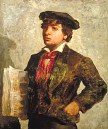|
|
 |
 |
|
Reading Guide |
| 7. |
Business
| - | Edward Bannister, Newspaper Boy, oil on canvas, 1869 |
| - | Warren Coleman, Appeal to support a black-operated cotton mill, Daily Concord [N.C.] Standard, 5 July 1896 |
|
|
 |
Best known for depictions of New England landscapes, Edward Bannister (1828-1901) was one of the leading black painters of the nineteenth century. Born in Canada, his mother was of Scottish descent, his father from Barbados. As a young seaman, he travelled to Boston and New York, where his desire to paint was nourished by visits to museums. His Newspaper Boy inevitably calls to mind the protagonists of Horatio Alger novels, and indeed, the painting appeared in 1869, just one year after Alger published his enormously popular Ragged Dick, or Street Life in New York. The racial identity of Bannister's boy is ambiguous. While the painting suggests some of the plucky resolve of an Alger character, it also captures the anxiety of a boy who, no matter how hard he tries, is unlikely to make it through the exertion of individual will. (When teaching the era of the Robber Barons, you might get at the underside of rugged individualism by asking your students to comment on this picture without knowledge of the artist.) For this newsboy to succeed, a whole race will have to make economic progress in this country, a cause Warren Coleman, a black businessman from North Carolina, tried to advance with his call to support a black-run cotton mill. Coleman understood that the mill was no mere business enterprise. 3 pages.
Discussion questions
- What is the setting of Newspaper Boy?
- How would you characterize the boy's attire, his pose?
- What is the tone of the picture? What elements create the tone?
- Compare Bannister's definition of space with that of Anshutz's in The Way They Live.
- How does Coleman invoke the economic spirit of the time in his call?
- Why and how is the mill more than a business enterprise?
|
» Link |
 |
 |
Topic Framing Questions
| • |
What roles did institutions play in African American life at this time? |
| • |
In what ways did institutions shape and reflect African American identity?
|
|
|
 |
 |
|
 |
